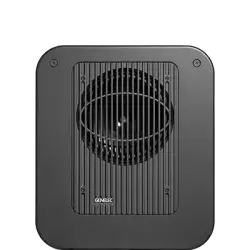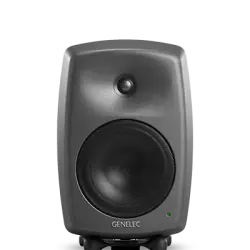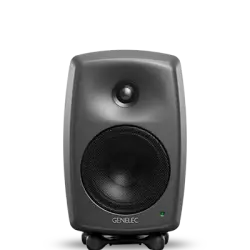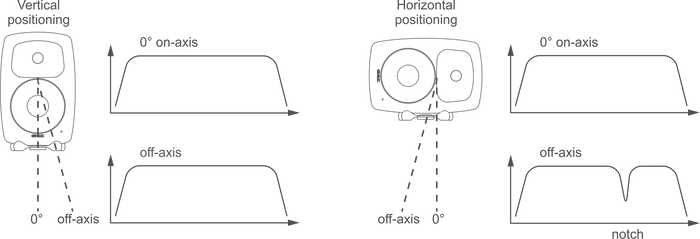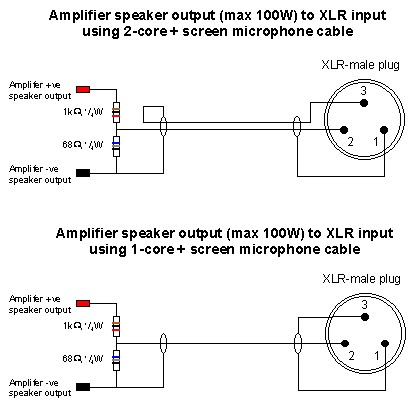Suorituskykyinen 8040B soveltuu moniin käyttötarkoituksiin, kuten audio- ja videotuotantoympäristöihin.
8040B
Studiomonitori

Active Crossovers

Directivity Control Waveguide (DCW™)

SPL
105 dB

Taajuusvaste
41 Hz - 25 kHz (-6 dB)

Mitat
H 365 x W 237 x D 223 mm, Iso-Podin kanssa™ (muunna tuumiksi)

Tinkimätöntä
8040B on erittäin suorituskykyinen tarkkailukaiutin ja soveltuu siten moniin käyttötarkoituksiin, kuten äänitysstudioihin, jälkikäsittelyyn, ulkolähetysautoihin sekä radio- ja tv-lähetystarkkaamoihin.

Tehoa ja tarkkuutta
Genelec 8040B on pienikokoinen tarkkailukaiutin, jossa on suuri maksimiäänenpaine, erittäin tasainen taajuusvaste ja laaja taajuuskaista. 8040B:n perustana ovat laadukkaat kaiutinelementit, optimoidut elementtikohtaiset tehovahvistimet, aktiiviset jakosuotimet ja elementtien suojapiirit. 8040B:ssä on Minimum Diffraction Enclosure (MDE™) -kotelo ja edistynyt Directivity Control Waveguide (DCW™) -suuntain. Kaiutin tuottaa ensiluokkaisen taajuusvasteen ja neutraalin äänikuvan kaikissa tuotantoympäristöissä. 8040B:ssä on Genelecin Intelligent Signal Sensing (ISS™) -toiminto, joka kytkee kaiuttimen automaattisesti valmiustilaan käytön päätyttyä. ISS on ErP 2013 -direktiivin mukainen.
8040B
Palkinnot

Genelec 8000 Series was Awarded a MIPA Award 2005 for Best Nearfield Studio Monitors
Genelec Oy: the world leader in active studio monitor speakers, was awarded a prestigious MIPA (Music Industry Press Award) for Best Studio Monitor (Nearfield) for its latest 8000 series of monitors at the Musikmesse, last month.
This award has become the 'Grammy' of the Musical Instrument and Pro Audio industries. Fifty-eight music press magazine from all over the globe cast their vote to make Genelec winner of the category.
Genelec 8000 series studio monitors
The 8000 Series of near-field, two-way systems took two years to develop. It features a new approach to enclosure design, driver technology and active electronics to further reduce distortion and provide an outstanding performance.
All three models in the 8000 series feature die-cast aluminium, minimum diffraction enclosures (MDE™) which have large internal volumes, softly curved edges and outstanding strength to help reduce linear and non-linear distortion. They also incorporate Advanced Directivity Controlled Waveguide (DCW™) to provide extremely accurate control of the speaker's directivity.
8030A studio monitor
The 8030A has a 5 inch bass driver and 3/4 inch tweeter. The free field frequency response is 55Hz to 21kHz, Peak SPL per pair is 108dB driven by a pair of 40 watt amplifiers.
8040A studio monitor
The 8040A has a 6 1/2 inch bass driver and 3/4 inch tweeter. The free field frequency response is 45Hz to 21kHz. Peak SPL per pair is 115dB driven by a pair of 90 watt amplifiers.
8050A studio monitor
The largest model the 8050A features an 8 inch bass driver and 1inch tweeter. The free field frequency response is 35Hz to 21 kHz. Peak SPL is 120dB and bass and treble amplification is 150 and 120 watts respectively.
2005

SPL
105 dB

Vahvistimen teho
90 W Basso (AB-luokka) + 90 W Diskantti (AB-luokka)

Taajuusvaste
41 Hz - 25 kHz ("-6 dB")

Taajuusvasteen tarkkuus
± 2 dB (48 Hz - 20 kHz)

Kaiutinelementtien mitat
⌀ 165 mm Basso + ⌀ 19 mm Diskantti (muunna tuumiksi)

Mitat
H 365 x W 237 x D 223 mm, Iso-Podin kanssa™ (muunna tuumiksi)

Paino
9.4 kg / 20.7 lb

Liitännät
1 x XLR Analoginen Sisääntulo
8040B Studio Monitor
Studiomonitori
Tekniset tiedot
Suorituskykyinen 8040B soveltuu moniin käyttötarkoituksiin, kuten audio- ja videotuotantoympäristöihin.

Järjestelmän tiedot
Taajuusvaste
48 Hz - 20 kHz (± 2 dB)
Alarajataajuus -6 dB
41 Hz
Ylärajataajuus -6 dB
25 kHz

SPL
Maksimiäänenpaine Maksimiäänenpaineen piikki, kaiutinpari mitattuna musiikkimateriaalilla konsolin päällä 1 metrin etäisyydeltä.
≥115 dB
Hetkellinen maksimiäänenpaine Lyhyen ajan maksimiäänenpaine siniaallolla puoliavaruudessa, keskiarvo 100 Hz - 3 kHz, 1 metrin etäisyydeltä.
≥105 dB
Pitkäkestoinen maksimiäänenpaine Pitkän ajan RMS-maksimiäänenpaine samoissa olosuhteissa IEC-painotetulla melulla 1 metrin etäisyydeltä (kaiuttimien suojapiirien rajoittama).
≥99 dB
Akustinen pohjakohinataso
Akustinen pohjakohinataso Kaiuttimen oma melutaso 1 metrin etäisyydeltä vapaakentässä (A-painotettu).
≤10 dB SPL
Paino
Paino9.4 kg (20.7 lb)
Mitat
Korkeus
350 mm
Korkeus pöytäjalustan kanssa
365 mm
Leveys
237 mm
Syvyys
223 mm

Kotelo
Kotelomateriaali
Die cast aluminium
Kotelotyyppi
Reflex port
Kaiutinelementit
Kaiutinelementtityyppi
Cone
Magnetically shielded
Halkaisija
165 mm
Kaiutinelementtityyppi
Metal dome
Magnetically shielded
Halkaisija
19 mm
Suuntaavuus

Harmoninen särö
> 100 Hz ≤0.5 %
Vahvistimet
Vahvistimet
90 W AB-luokka
90 W AB-luokka
Käyttöjännite
100, 120, 220 or 230VAC 50/60Hz according to region
Tehonkulutus
ISS-valmiustilassa
≤0.5 W
Ilman kuormaa
≤10 W
Täysi kuormitus
110 W
Jakosuodin
Liitännät
Sisääntulo XLR-naaras, balansoitu 10 kOhm
Jakotaajuus
Bass/Treble
3000 Hz
Tuotevaihtoehdot
Tuotekoodit
Lisävarusteet
Tuotekoodit
Tarkempia lisätietoja lisäksi tuoteoppaissa.
Avainteknologiat

Active Crossovers

Directivity Control Waveguide (DCW™)

Intelligent Signal Sensing (ISS™)

Iso-Pod™ Stand

Minimum Diffraction Enclosure (MDE™)

Optimized Amplifiers

Protection Circuitry

Reflex Port Design

Room Response Compensation

Versatile Mountings
Aktiivisessa jakosuotimessa käsitellään linjatasoista signaalia.

Aktiiviset jakosuotimet jakavat audiosignaalin taajuuskaistoihin, jotka ohjataan erillisiin tehovahvistimiin. Vahvistimet on kytketty kyseiselle taajuuskaistalle optimoituihin kaiutinelementteihin.
Aktiivikaiuttimissa käytetään sekä digitaalisia että analogisia jakosuotimia. Genelecin digitaalisissa aktiivijakosuotimissa on myös muita signaalinkäsittelytoiminnallisuuksia, kuten elementtien suojaus, lentoaikakompensointi ja taajuuskorjaus.
Genelecin analogisissa aktiivijakosuotimissa perustuu elektronisiin komponentteihin, jotka käsittelevät matalatasoista signaalia ennen tehovahvistusta. Aktiiviset jakosuotimet eroavat toimintaperiaatteeltaan passiivisista jakosuotimista, joissa käsitellään voimakkaita signaaleja, suurta virtaa ja toisinaan myös suurta jännitettä.
Tyypillisessä kaksitiekaiuttimessa tulosignaali jakosuodatetaan kahdelle erilliselle tehovahvistimelle, joista toinen ohjaa bassoelementtiä ja toinen diskanttielementtiä.
Aktiivisella jakosuodinteknologialla on useita etuja:
- Elementin sähködynaamiset muutokset eivät vaikuta taajuusvasteeseen.
- Signaalia voidaan säätää joustavasti käytettävän elementin ominaisuuksien mukaisesti.
- Jokaisen elementin tulosignaali prosessoidaan ja vahvistetaan yksilöllisesti. Yksittäisten elementtien signaalit eivät häiritse toisiaan, mikä vähentää keskeismodulaatiosäröä ja yliohjausongelmia.
- Elementtien välisiä herkkyyseroja voidaan kompensoida.
- Elementin ominaisuuksiin liittyviä taajuus- ja vaihevasteen poikkeamia voidaan kompensoida halutulla päästökaistalla.
- Aktiivinen jakosuodin mahdollistaa lisäksi taajuusvasteen säätämisen sekä kaiuttimen optimoinnin kaiutinjärjestelmään ja erilaisiin kuunteluympäristöihin ilman ulkoisia taajuuskorjaimia. Tuloksena on yksinkertainen, luotettava, tehokas, tarkka ja johdonmukaisesti käyttäytyvä aktiivikaiutinjärjestelmä.
Directivity Control Waveguide (DCW™) -suuntain tuottaa tasaisen taajuusvasteen laajalle kuuntelualueelle.

Vallankumouksellinen Directivity Control Waveguide™ (DCW™) -teknologia parantaa huomattavasti suoraan säteilevän monitiekaiuttimen suorituskykyä.
Tavoite on sovittaa taajuusvaste ja elementtien suuntaavuus kaiuttimessa. Lopputuloksena saavutetaan erinomainen taajuusvaste sekä kaiuttimen akustisella akselilla että sivusta mitattuna.
Parantunut kontrolloitu suuntaavuus vähentää huoneheijastumia kuuntelupaikalle. Tämä parantaa stereokuvaa ja asettaa vähemmän vaatimuksia huoneakustiikalle.
DCW-teknologia parantaa elementin herkkyyttä jopa +6 dB:ä, mikä mahdollistaa suuremman kokonaisäänenpaineen vähentäen samalla säröä ja parantaen luotettavuutta.
###DCW™-suuntaimen tärkeimmät edut:
- Tasainen taajuusvaste laajemmalle kuuntelualueelle
- Parantunut suoran äänen suhde heijastuneeseen ääneen vähentää tilan vaikutusta lopputulokseen
- Tarkempi stereokuva
- Parantunut elementtien hyötysuhde
- Järjestelmän suurempi maksimiäänenpaine
- Pienentynyt elementtien särö
- Vähemmän kaiutinkotelon reunan aiheuttamaa äänen heijastumista
- Parantunut elementtien luotettavuus, koska saman äänenpaineen tuottamiseen tarvitaan vähemmän tehoa ja pienempi kalvon liikepoikkeama
Intelligent Signal Sensing (ISS™) -valmiustilatoiminto vähentää virrankulutusta.

Genelec kehitti vuonna 2013 Intelligent Signal-Sensing -piirin, joka täyttää sekä ErP-direktiivin vaatimukset että Genelecin omat direktiiviä tiukemmat vastuullisuusvaatimukset.
ISS™-piiri seuraa kaiuttimien signaalinsyöttöä ja havaitsee, milloin signaali on käytössä. Jos ISS-piiri ei havaitse audiosignaalia hetkeen, se asettaa kaiuttimen valmiustilaan, jossa kaiuttimen virrankulutus on alle 0,5 wattia. Kun syöttösignaali havaitaan, kaiutin kytkeytyy päälle itsestään. Kaiutinjärjestelmä alkaa siis säästää sähköä heti, kun työskentely katkeaa.
Jokaisen kaiuttimen taustalevyssä on huonevasteen säätimien vieressä ISS Disable -kytkin. Kun päävirtakytkin on asennossa ON, ISS™-toiminto on oletusarvoisesti päällä.
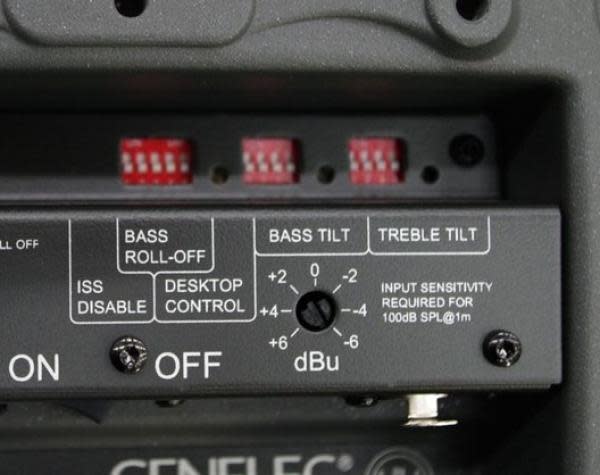
Jos ISS-toimintoa ei haluta käyttää, se voidaan poistaa käytöstä kääntämällä ISS Disable -kytkin asentoon ON. Tällöin kaiuttimen virransyöttöä ohjataan päävirtakytkimestä.
Päävirtakytkin katkaisee kaiuttimen virransyötön kokonaan.
Mekaanisia värinöitä vaimentava Iso-Pod™ -alusta parantaa äänikuvan tarkkuutta.

Vaikka vapaasti seisovien kaiuttimien alle suositellaan yleisesti tukevia jalustoja, on varsin yleistä että kaiuttimet sijoitetaan suoraan pöydälle tai äänipöydän mittarisillalle. Tällaisesta sijoituksesta aiheutuu kuitenkin haitallisia lieveilmiöitä: Kaiuttimen suuntaus kohti kuulijaa on vaikeaa ja kaiuttimen sekä alustan välille syntyy haitallisia mekaanisia värinöitä. Kaiuttimen ollessa pöydällä työtasosta aiheutuu heijastumia, jotka aiheuttavat kampasuodinilmiöstä johtuvaa taajuusvasteen vääristymistä.
Genelec on kehittänyt näiden ongelmien ratkaisemiseksi tehokkaan ja käytännöllisen Isolation Positioner/Decoupler (Iso-Pod™) -alustan, joka kiinnitetään jousella kaiuttimen alumiinikoteloon. Alusta on valmistettu joustavasta kumimaisesta materiaalista. Tukevasti sekä pysty- että vaaka-asentoon Iso-Pod-alustan päälle asettuvaa kaiutinta voidaan kallistaa ±15 asteen kulmaan. Kaiuttimen akustinen akseli voidaan kohdistaa tarkasti kohti kuuntelijaa säätämällä kaiuttimen kulmaa Iso-Pod-alustan päällä.
Mekaaniset eristys- ja vaimennusominaisuudet vähentävät tukipinnoista syntyvän haitallisen värähtelyn aiheuttamaa keskiäänen värittymistä.
Innovatiivinen Iso-Pod™-alusta on oleellinen osa Genelecin kaiutinmuotoilua ja se tarjoaa huomattavia käytettävyyteen sekä äänenlaatuun vaikuttavia etuja.
Minimum Diffraction Enclosure (MDE™) -kotelo tuottaa värittymättömän äänen.
Etulevyn akustisista epäjatkuvuuskohdista syntyvä diffraktio on tyypillinen vapaasti sijoiteltavan kaiuttimen ongelma. Kotelon terävät kulmat aiheuttavat heijastuksista johtuvia toisioäänilähteitä, jotka värittävät ääntä ja heikentävät äänikuvan tarkkuutta.
Parantaakseen vapaasti sijoiteltavan kaiuttimen taajuusvasteen sekä tehovasteen tasaisuutta, Genelec on kehittänyt innovatiivisen Minimum Diffraction Enclosure (MDE™) -kaiutinkotelon, jossa on kaarevat sivut sekä pyöristetyt kulmat. Poikkeuksellisen tasaisen taajuusvasteen lisäksi kotelorakenteella saavutetaan erinomaiset äänikuvaominaisuudet.
Kompaktin ja tyylikkään ulkoasun saavuttamiseksi kotelon materiaaliksi on valittu painevalettu alumiini, joka mahdollistaa kotelon kokoon suhteutettuna suuren sisätilavuuden bassoelementin herkkyyden maksimoimiseksi. Alumiini on kevyttä, jäykkää ja hyvin vaimentavaa, joten se on erinomainen materiaali ohutseinäisen ja akustisesti "kuolleen" kotelon valmistamiseen. Alumiinikotelo suojaa tehokkaasti elektromagneettiselta säteilyltä ja se toimii myös vahvistimien jäähdytyselementtinä. Kotelo valetaan kahtena kappaleena, jolloin se pystytään avaamaan helposti esimerkiksi huoltoa varten.

Directivity Control Waveguide (DCW™) -suuntain integroidaan MDE™-koteloon hallitun suuntaavuuden saavuttamiseksi. Vakiosuuntaavuuden alarajataajuus määräytyy suuntaimen koon perusteella, jolloin suuremmalla suuntainpinta-alalla saavutetaan hallitumpi suuntaavuuskäyttäytyminen. Hallittu sivukenttäsäteily mahdollistaa suuren käyttökelpoisen kuuntelualueen, mikä on erittäin tärkeää monikanavaisessa äänentarkkailussa. Hallittu suuntaavuus vähentää myös rajapintaheijasteiden merkitystä, jolloin monitorointijärjestelmä toimii johdonmukaisesti erilaisissa akustisissa ympäristöissä.


Elementtikohtaisesti optimoidut tehovahvistimet.

Elektroniset jakosuotimet jakavat audiosignaalin taajuuskaistan osiin, jotka voidaan ohjata erillisiin vahvistimiin. Vahvistimet on liitetty kyseiselle taajuuskaistalle optimoituihin muuntimiin.
Tyypillisessä kaksitiekaiuttimessa aktiivinen jakosuodin tarvitsee kaksi vahvistinta: yhden bassoelementille ja toisen diskanttielementille. Vahvistimet liitetään suoraan aktiivikaiuttimien elementteihin, jolloin vahvistimien kuormitus on tunnettu ja yksinkertaisempi. Jokaisella elementtikohtaisella vahvistimella on vain rajallinen taajuusalue, jota se vahvistaa (vahvistin sijoitetaan aktiivisen jakosuotimen taakse), mikä yksinkertaistaa rakennetta.
Aktiivisella rakenteella on useita etuja:
- Vahvistimet liitetään suoraan kaiutinelementteihin, mikä tehostaa vahvistimien elementin äänikäämin vaimennuksen hallintaa ja vähentää dynaamisten muutosten esiintymistä elementin sähköominaisuuksissa. Se saattaa parantaa järjestelmän siirtymävastetta.
- Vahvistimen lähtövaatimukset ovat pienemmät. Kun energiaa ei mene hukkaan passiivisen jakosuotimen komponenteissa, vahvistimen tehovaatimukset ovat huomattavasti pienemmät (jopa puolta pienemmät joissakin tapauksissa) ilman, että kaiuttimen akustinen teho heikkenee. Tämä saattaa pienentää kustannuksia ja parantaa äänenlaatua ja järjestelmän luotettavuutta.
- Kun vahvistimen ja elementin välissä ei tapahdu hävikkiä, saavutetaan äärimmäinen akustinen tehokkuus.
- Aktiivinen teknologia pystyy tuottamaan ylivoimaisen äänentoiston suhteessa kokoon ja matalaan alarajataajuuteen.
- Kaikki kaiuttimet toimitetaan tehtaalla sovitettuina järjestelminä (vahvistimet, jakosuotimet ja kotelo-elementtijärjestelmät).
Yliohjauksen suojapiiri takaa turvallisen käytön ja elementtien pitkäikäisyyden.

Kriittisissä audiotuotantoympäristöissä on ratkaisevaa, että monitorointijärjestelmä on luotettava ja aina käytettävissä. Yksi tärkeimmistä syistä Genelecin menestykseen lähetystarkkaamokäytössä on tuotteidemme luotettavuus. Luotettavuuden takeena on sisäinen suojapiiri, joka on ollut kaikissa tuotteissa vuodesta 1978 lähtien.
Suojapiiri ehkäisee elementtien vikatiloja havaitsemalla signaalitasoja. Mikäli signaalissa esiintyy yhtäkkisiä piikkejä tai jatkuvia liian korkeita tasoja, suojapiiri laskee signaalin tasoa automaattisesti. Suojapiirin toiminta ei luonnollisestikaan vaikuta äänenlaatuun millään tavalla työskenneltäessä kaiuttimen määritellyissä käyttöolosuhteissa. Se vain ehkäisee signaaleja rikkomasta kaiutinta.

Suojapiirin ominaisuudet ja edut:
- Laskee signaalin tasoa tarvittaessa (esimerkiksi kun elementin äänikäämin lämpötila saavuttaa turvarajan), mikä parantaa kaiuttimen luotettavuutta merkittävästi.
- Jokaisen kaiuttimen ja alabassokaiuttimen sopiva suojapiirirakenne sallii järjestelmän äänitason maksimoimisen.
Edistynyt refleksiputken muotoilu parantaa bassotoiston ulottuvuutta.

Genelec käytti bassorefleksirakennetta jo ensimmäisessä tarkkailukaiuttimessaan S30:ssa vuonna 1978. Genelec on siitä lähtien tutkinut ja kehittänyt refleksiputken suorituskykyä sekä tehokkuutta. Kehitystyön tavoite on ollut parantaa bassotoiston ulottuvuutta ja äänenpainekapasiteettia erinomaisen matalien taajuuksien artikulaation ja tarkkuuden tuottamiseksi.
Sekä bassoelementti että refleksiaukko vaikuttavat refleksikotelon kokonaissäteilyyn. Suurin osa säteilystä on lähtöisin elementistä, mutta refleksikotelon resonanssitaajuudella elementin liikepoikkeaman amplitudi on pieni, jolloin suurin osa säteilystä tulee aukosta.
Virtausnopeuden minimoimiseksi putken poikkipinta-alan täytyy olla suuri. Kaiutinkotelon koko rajoittaa usein refleksiputken pituutta.
Pitkä kaareva refleksiputki maksimoi ilmavirtauksen, jotta kaiutin pystyy tuottamaan syvän bassotoiston ilman kompressiota. Putki päättyy leveään pyöreäreunaiseen aukkoon, joka sijaitsee kotelon takana minimoiden putken virtausääniä ja tuottaen erinomaisen bassoartikulaation.
Putken kaareva muoto on tarkoin suunniteltu ja se vähentää virtausääniä, kompressiota ja säröä. Putken sisäpään muotoilu minimoi suorille refleksiputkille tyypillisiä yskähdysääniä ja turbulenssia.
Huolellisesti suunniteltu refleksiputken rakenne vähentää bassoelementin liikepoikkeamaa ja parantaa matalien taajuuksien toiston lineaarisuutta sekä äänenpainekapasiteettia.
Huonevasteen kompensointi mahdollistaa kaiuttimen sovittamisen akustiseen ympäristöön.
Huoneakustiikan ja kaiuttimen säteilyn välinen suhde on monimutkainen asia. Jokainen tila vaikuttaa tarkkailukaiuttimen vasteeseen omalla tavallaan – esimerkiksi heijastavat ja vaimentavat tilat – samoin kuin kaiuttimen sijoittaminen seinää vasten tai irti seinästä.
Kaikissa Genelecin kaiutinjärjestelmissä on huonevasteen korjaus, joka kompensoi tilan vaikutuksia äänentoistoon ja tuottaa tasaisen taajuusvasteen kuuntelupaikassa.
Analogiset järjestelmät
Genelecin analogiset kaiutinjärjestelmät tarjoavat monipuoliset huonevasteen säätömahdollisuudet. Säätömahdollisuuksia ovat (kaiutinmallista riippuen):
- Bass Roll-Off ja Bass Tilt
- Treble Tilt ja Treble Roll-Off
- Bass Level
- Midrange Level
- Treble Level
- Desktop Control

Matalilla taajuuksilla käytettävissä on kaksi pääsäätöä. Bass Tilt toimii hyllysuodattimena, kun taas Bass Roll-off sallii optimoida matalien ja erittäin matalien taajuuksien taajuusvastetta eri kohteissa. Bass, Midrange ja Treble Level ovat käytettävissä isoissa järjestelmissä. Nämä säädöt optimoivat eri päästökaistojen välistä suhteellista tasapainoa.
Kunkin kaiuttimen käyttöohje ja datalehti sisältävät luettelon erilaisten asennusten ensisijaisista huonevasteasetuksista. Ne on määritetty pitkän käytännön kokemuksemme ja erilaisissa akustiikkaympäristöissä tekemiemme mittausten perusteella.
Smart Active Monitor (SAM™) -tarkkailukaiuttimet
Genelecin SAM-järjestelmät ovat kokonaisvaltainen, ratkaisukeskeinen, älykkäästi verkostoituva tuotevalikoima, jonka kaikki tuotteet käyttävät Genelec Loudspeaker Manager (GLM™) -ohjelmistoa ja automaattisesta AutoCal™-kalibrointitekniikkaa.
Genelec AutoCal on alan ensimmäinen täysin integroitu ja automaattinen prosessi GLM-ohjausverkkoon liitettyjen kaiuttimien mittaamiseen, analysointiin ja kalibrointiin. Järjestelmä mittaa kuuntelualueen vasteen ja tekee tarvittavat kompensaatiot matalilla ja matalilla keskitaajuuksilla ja minimoi näin huoneakustiikkaa heikentävät poikkeamat ja eri kuuntelupaikkojen väliset erot. AutoCal sovittaa kaikkien verkon kaiuttimien suhteelliset tasot, kompensoi etäisyyseroja ja säätää kaikkien verkon alabassokaiuttimien jakosuodinvaiheet (AutoPhase).
Acoustic Response Editor tarjoaa tarkan graafisen esityksen mitatusta vasteesta, suodatuksen kompensoinnista ja kunkin kaiuttimen järjestelmävasteesta sekä mahdollisuuden akustiikka-asetusten manuaaliseen säätämiseen.
Monipuoliset kiinnitysvaihtoehdot soveltuvat useimpiin asennusratkaisuihin.

Genelecin kaiuttimissa on monipuoliset ripustusmahdollisuudet, jotka tekevät asennuksesta helppoa kaikissa kohteissa. Oikein sijoitetut kaiuttimet käyttäytyvät ihanteellisesti erilaisissa käyttöympäristöissä.
Laaja lisävarustevalikoimamme ja painevalettujen alumiinikoteloiden takalevyihin integroidut kiinteät M6-kiinnityspisteet tarjoavat ratkaisun useimpiin asennustilanteisiin. Pienissä kaiutinmalleissa kotelon pohjassa on 3/8-tuuman kierreinsertti, jota käyttäen kaiutin voidaan asentaa tukevaan mikrofonitelineeseen tai jalustaan. Suuremmissa ja painavammissa malleissa on M10-kiinnityspisteet. Lattiatelineisiin on saatavilla myös mallikohtaiset Iso-Pod jalusta-adapterit, joiden avulla saavutetaan kattavat säätömahdollisuudet sekä hyvä mekaaninen eristys kaiuttimen ja jalustan välille.
Näiden ominaisuuksien ansiosta tuotteitamme käytetään nykypäivänä ammattikäyttökohteiden lisäksi sekä julkistiloissa että kotikohteissa kaikkialla maailmassa.
Referenssit
Tuotantotalo Director's Cut luottaa Genelecin monitorointiin myös TVOF-tuotannossa!
Genelec Calibration | Room EQ Wizard & DIP switches explained
Tuotantotalo Director's Cut luottaa Genelecin monitorointiin myös TVOF-tuotannossa!
Äänisuunnittelija Tomi Kolistaja toimii äänikäyttömestarina The Voice of Finlandin livetuotannossa. Tomi esitteli meille Director's Cutin ulkotuotantoautoa, josta käsin varmistetaan äänenlaatu lähetyksen aikana. Auton äänitarkkaamo on varustettu Genelecin 8040 ja 8030 studiomonitoreilla, sekä 7060 subwooferilla.
"Ask the experts with Alex Theakston: Monitoring sound in the studio" is an article about the 8000 range studio monitors. It was published in the TV-Bay Magazine in November 2012.
{"fi-FI":""Ask the experts with Alex Theakston: Monitoring sound in the studio" is an article about the 8000 range studio monitors. It is written by Alex Theakston, and it was published in the TV-Bay Magazine in November 2012.","ru-RU":""Ask the experts with Alex Theakston: Monitoring sound in the studio" is an article about the 8000 range studio monitors. It is written by Alex Theakston, and it was published in the TV-Bay Magazine in November 2012.","de-DE":""Ask the experts with Alex Theakston: Monitoring sound in the studio" is an article about the 8000 range studio monitors. It is written by Alex Theakston, and it was published in the TV-Bay Magazine in November 2012.","en-US":""Ask the experts with Alex Theakston: Monitoring sound in the studio" is an article about the 8000 range studio monitors. It is written by Alex Theakston, and it was published in the TV-Bay Magazine in November 2012.","sv-SE":""Ask the experts with Alex Theakston: Monitoring sound in the studio" is an article about the 8000 range studio monitors. It is written by Alex Theakston, and it was published in the TV-Bay Magazine in November 2012.","es-ES":""Ask the experts with Alex Theakston: Monitoring sound in the studio" is an article about the 8000 range studio monitors. It is written by Alex Theakston, and it was published in the TV-Bay Magazine in November 2012."}
Etsi jälleenmyyjäsi

Dokumentit
Tiedostot
Line Drawings (DWG) 8040B Line Drawings (PDF) 8040B 8040B - Simulation File (CLF) 8040B - Simulation File (EASE3) 8040B - Simulation File (EASE4)UKK
Damping Materials Used in Our Monitors
Genelec products use various damping materials such as glass fiber wool, linen fiber wool, and polyester fiber based material (PES). The tables presented below provide a detailed listing of our monitor models and the type of damping material used in each model.
During operation, the air moving in and out of the monitor loudspeaker or subwoofer bass reflex openings does not emit significant amounts of fiber particle dust. The PES wool as material does not emit dust. The linen wool, and glass fiber wool can emit minimum amounts of dust during very high sound level operation. This fiber dust is not hazardous to health.
Studio monitors
| SAM™ Studio Monitors | Damping material type |
|---|---|
| 1032C | PES |
| 8320A | PES |
| 8330A | PES |
| 8340A | PES |
| 8350A | PES |
| 8130A | PES |
| 8240A | PES |
| 8250A | PES |
| 8331A | PES |
| 8341A | PES |
| 8351A | PES |
| 8351B | PES |
| 8361A | PES |
| S360 | PES |
| 8260A | Linen wool |
| 1238CF | Linen wool |
| 1238DF | Linen wool |
| 1237A | Linen wool |
| 1238A | Glass wool |
| 1238AC | Glass wool |
| 1234A | Glass wool |
| 1234AC | Glass wool |
| 1236A | Glass wool |
| SAM™ Studio Subwoofers | Damping material type |
|---|---|
| 7260A | Linen wool |
| SE7261A | Linen wool |
| 7270A | Linen wool |
| 7271A | Linen wool |
| 7350A | Linen wool |
| 7360A | Linen wool |
| 7370A | Linen wool |
| 7380A | Linen wool |
| 7382A | Linen wool |
| 8000 Series Studio Monitors | Damping material type |
|---|---|
| 8010A | PES |
| 8020D | PES |
| 8030B | PES |
| 8030C | PES |
| 8040B | PES |
| 8050B | PES |
| 1000 Series Studio Monitors | Damping material type |
|---|---|
| 1032B | Linen wool |
| 1037C | Linen wool |
| 1038CF | Glass wool |
| 1038B | Glass wool |
| 1038BC | Glass wool |
| 1034B | Glass wool |
| 1034BC | Glass wool |
| 1039A | Glass wool |
| 1035B | Glass wool |
| 1036A | Glass wool |
| M Series Studio Monitors | Damping material type |
|---|---|
| M030 | PES |
| M040 | PES |
| 7000 Series Studio Subwoofers | Damping material type |
|---|---|
| 7040A | Linen wool |
| 7050B | None |
| 7050C | Linen wool |
| 7060B | Linen wool |
| 7070A | Linen wool |
| 7071A | Linen wool |
| 7073A | Glass wool |
Home Speakers
| G Series Active Speakers | Damping material type |
|---|---|
| G One | PES |
| G Two | PES |
| G Three | PES |
| G Four | PES |
| G Five | PES |
| F Series Active Subwoofers | Damping material type |
|---|---|
| F One | None |
| F Two | PES |
| Home Theater Speaker Series | Damping material type |
|---|---|
| HT210B | Linen wool |
| HT312B | Glass wool |
| HT315B | Glass wool |
| HT320BC | Glass wool |
| HT324A | Glass wool |
| HT324AC | Glass wool |
| HT330A | Glass wool |
| Home Theater Subwoofer Series | Damping material type |
|---|---|
| HTS3B | None |
| HTS4B | None |
| HTS6 | Glass wool |
Installation Speakers
| 4000 Series Installation Speakers | Damping material type |
|---|---|
| 4010A | PES |
| 4020B | PES |
| 4020C | PES |
| 4030B | PES |
| 4030C | PES |
| 4040A | PES |
| Architectural Speaker Series | Damping material type |
|---|---|
| AIC25 | PES |
| AIW25 | PES |
| AIW26 | Linen Wool |
| AIW26B | Linen Wool |
| AOW312 | Glass wool |
| 5041A | Linen Wool |
Input sensitivity can be controlled with a combination of a rotary controller and level range switches on the products. The sensitivity on SAM™ (Smart Active Monitoring) products can be set more precisely using the GLM (Genelec Loudspeaker Manager) software and a computer.
The nominal analogue input sensitivity in Genelec studio monitors is -6 dBu which produces 100 dB SPL audio output at 1 meter in an anechoic room.
The nominal digital input sensitivity is set so that a 0 dB FS digital input produces a theoretical 130 dB SPL sound level at 1 meter in an anechoic room.
The actual maximum SPL depends on the product capabilities and may be lower than 130 dB SPL.
Acoustic treatment
This is a very broad subject area covering room geometry, reverberation time, sound reflection and refraction, material properties, etc. However, we built a brief checklist to cover the most important features that a listening room should have. Once the room has been acoustically treated the studio monitors can be installed.
A Brief Checklist for Listening Room Setup
- Ensure that the reverberation time is low and approximately constant with frequency.
- Primary sources of reflection should be treated, so that reflected levels are at least 10 dB down from the direct sound pressure level at least during the first 15 ms after the arrival of the direct sound at the listening location.
- The front wall should be hard and smooth if monitors are flush-mounted. The front wall can be absorptive if monitors are free-standing.
Setting Up Studio Monitors
- Position the monitors according to the standard orientations (angles) from the listening position.
- Position monitors at equal physical distance from the listening position, or use GLM AutoCal to electronically compensate for differences in monitor distances.
- Position the monitors so that there are no cancellation effects from the side walls and the wall behind the monitor.
- Turn the monitors towards the listening position horizontally and vertically.
- Set the room compensation controls as suggested in the Operating Manual/Quick Setup Guide or use GLM AutoCal to compensate for the room acoustics in the case of SAM (Smart Active Monitoring) systems.
"Ask the experts with Alex Theakston: Monitoring sound in the studio" is an article about the 8000 range studio monitors. It was published in the TV-Bay Magazine in November 2012.
"Ask the experts with Alex Theakston: Monitoring sound in the studio" is an article about the 8000 range studio monitors. It is written by Alex Theakston, and it was published in the TV-Bay Magazine in November 2012.
hello

























































